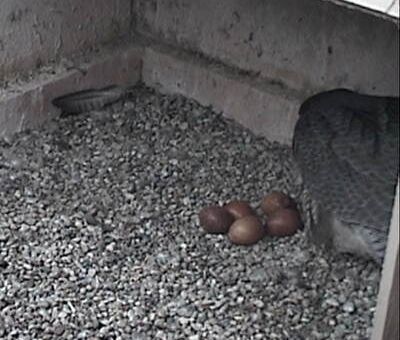
It looks to me like the egg at top right has a pip in it. See the dent?
This photo is from last evening at 7:50pm, so perhaps this egg will hatch today.
(photo from the National Aviary webcam at University of Pittsburgh)

It looks to me like the egg at top right has a pip in it. See the dent?
This photo is from last evening at 7:50pm, so perhaps this egg will hatch today.
(photo from the National Aviary webcam at University of Pittsburgh)
Thanks for the wonderful photo. Just added another word to my vocabulary.
Kate, Are your great photos from the still camera at COL? The streaming camera does not seem to give such vibrant colors. Is there some way for us to see the archived stills? Thanks for everything you do!
Yes, these are photos from the snapshot camera at http://aviary.org/cons/FalconCam/Cathedral_refreshCam.php
It does motion detection archiving but the archives are not publicly available.
what’s with this violent rubbing of the eggs? Is that what happens? Also, what happens when there is a hatchling ? But there are still eggs to hatch. Do they sit on the hatchling too?
The mother bird gets increasingly restless as the eggs are hatching.
The baby bird inside the egg hits the shell from inside using his “egg tooth” — a knob on the top of the beak that exists for this task. The chick hits the shell, then turns inside the egg and hits the next spot. This makes something like a dotted line and the blunt end of the shell eventually comes off whole.
The mother bird waits for this to happen and looks under her chest to see how it’s going. The chick must free itself.
Peregrine chicks cannot regulate their body temperature until they are about a week old so they must be brooded by the adult. This is just like incubation except the babies are out of the eggs.
This is truly fascinating to watch!
So I’m used to watching birds like robins and jays learn to fly. Usually when I witness this their first flights are awkward flutterings toward the ground – and if they’re lucky they snag a branch on the way down – making short flights between branches for a few days to strengthen their skills.
How does this work in peregrines?! Do they have to really fly on that first jump? Or is there room up on the cathedral to flitter around and get some wing strength first? Or, alternatively, is their first flight delayed longer than birds closer to the ground to allow them to get good wing strength/endurance?
Thanks.
First flight is delayed. They spend a lot of time in the nest before they are big enough to fly.
My Peregrine FAQ page has answers to many of your questions at http://www.birdsoutsidemywindow.org/peregrine-faqs/ Fledging is addressed in the last link in the Appearance & Behavior category.
Thank you so much for the info. I love the FAQ as well!
One other quick question…Dorothy really seems to love picking at the gravel. Is this just her restlessness again? Relieving boredom? Or does it serve some other purpose. It doesn’t really look like she’s grooming the scrape. I’ve seen her pick up rocks and just drop them several times – like a bird equivalent of twiddling thumbs. Or maybe that’s too much anthropomorphizing.
Funny you should ask that. Yes, she is puttering but there can be more to it than that. I wrote an FAQ about it: http://www.birdsoutsidemywindow.org/peregrine-faqs/question-is-she-eating-rocks/
doh – sorry I missed that one in the FAQ. I did read quite a lot of it today 🙂
It is 10:30pm and I am watching the COL nest. I really think I hear a baby, or babies, chirping! Is that possible? None have fully hatched though at this point, still seeing all 5 eggs.
I haven’t heard them but you may have. At this stage the chicks can make noise while inside the eggs. Very high peeps.
I thought I heard this as well!! So glad someone else did. I heard it until one or the other parents got on the eggs – so I thought maybe it was my imagination.
COOL!!
Having sound is fantastic!!
FIRST BABY! 22:20 April 21! (in “archive” time)
The first egg has definitely hatched! The chick is so cute! ^^
Correction, 23:20 — too excited to type 🙂